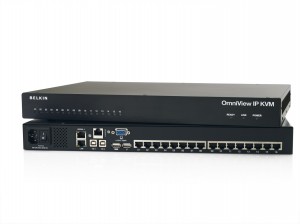After my Belkin 5126K broke down, I tried to get Belkin to fix it. I'm not very pleased with the results so far.
Try #1
Last tuesday, I filled in a RMA form to get my Belkin Omniview 5216K repaired or replaced. It doesn't boot at all, but instead of fixing the device, I got a mail with instructions to reset the device to factory defaults. Belkin probably gets a shitload of dumb customers that can be helped in a minute. But apparently that makes the support team try a lot of standard routines without even reading what the complaint is.
Anyways, I tried to see if the instructions were any good:
52xxK Series
In order to restore your KVM switch to factory defaults without using the web interface, follow the steps below:
Step 1 Take a USB flash drive (any type will do) and create a new text file in its root.
Step 2 Rename the file to 'default'. This file shouldn’t have any content or extension; it should just be an empty file with the size of zero.
Step 3 Connect the KVM switch to the monitor and connect the USB flash drive to one of the USB ports on the KVM switch.
Step 4 Restart KVM switch. The switch will boot, find the file, restore the factory settings, delete the file, and restart again. All these operations will be performed automatically.
Step 5 Wait for the On-Screen Display (OSD) menu to appear. When it does, the switch has been restored to its factory settings.
Of course that didn't fix anything, because to restore the settings to factory default, the device should at least load the bootloader. So I mailed them the results.
Try #2
This time, I got a mail to update the firmware. Didn't I just tell them that the device doesn't boot? I mailed them back. Again.
Try #3
After not hearing from Belkin, I decided to give them a call. No luck either. The guy I spoke to could do nothing more than write down my complaint for someone else to fix. After the weekend of course. Let's wait and see.
For now the device that cost me about €1590 hasn't been able to save me any trips to the datacenter, but cost me two instead.
© GeekLabInfo Review: Belkin KVM Omniview 5216K - part 2 is a post from GeekLab.info. You are free to copy materials from GeekLab.info, but you are required to link back to http://www.geeklab.info

